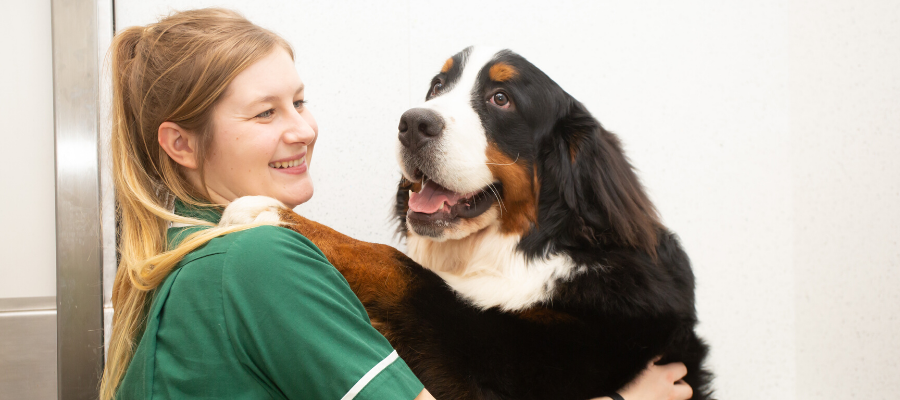What is the cranial cruciate ligament?
The cranial cruciate ligament (CrCL) in dogs is a band of tough fibrous tissue that attaches the femur (thigh bone) to the tibia (shin bone), preventing the tibia from shifting forward relative to the femur. It also helps to prevent the stifle (knee) joint from over-extending or rotating.
The ligament rarely breaks from trauma but usually degenerates slowly over time.
Does my dog have cruciate disease?
Limping is the most common sign of CrCL injury. This may appear suddenly from exercise in some dogs, or it may be progressive and intermittent in others. Some dogs are affected in both knees, and these dogs often find it difficult to rise from laying down and may walk in a “pottery” manner.
How is cranial cruciate ligament injury diagnosed?
Diagnosis in dogs with complete rupture of the CrCL is usually based on an initial examination by one of our veterinary surgeons, with demonstration of looseness of the joint by specific manipulations of the stifle. To confirm diagnosis, x-rays under general anaesthetic are required.
How is cruciate ligament injury treated?
Once CrCl rupture is confirmed with x-rays, the veterinary surgeon will discuss the different options available for your pet. Different treatments are recommended on a case-by-case basis.
Non-surgical management
Non-surgical management is rarely recommended, except where the risks of a general anaesthetic and surgery outweigh the benefits (e.g. patients with severe heart disease). The fundamentals of non-surgical treatment are body weight management, physiotherapy, reduced exercise and medication (painkillers). Dogs greater than 15kg have a very poor chance of becoming clinically normal with non-surgical treatment. Dogs weighing less than 15kg and cats have a better chance, although improvement usually takes several months and is rarely complete.
Surgical management
Dependent on the needs of the patient, they may require extrascapular lateral suture stabilisation (ElSS), a tibial plateau levelling osteotomy (TPLO) or a tibial-wedge osteotomy (TWO). We can usually offer ELSS and TPLO in house but would have to refer the patient externally for a TWO if that was the recommended treatment option.
Extrascapular Lateral Suture Stabilisation (ELSS)
During ELSS surgery a strong suture is placed around the knee joint to prevent the tibia and femur from moving too far apart. This prevents the tibia from slipping forward relative to the femur during weight bearing. After a healing period, scar tissue forms around the knee, providing the same support as the suture. The suture will eventually weaken but by that point the scar tissue will be providing the required support.
Tibial Plateau Levelling Osteotomy (TPLO)
TPLO involves changing the angle of the top of the shin bone (the tibial plateau) by cutting the bone, rotating it, and stabilising it in a new position with a plate and screws.
X-rays are obtained at the end of the operation to assess the new angle of the top of the shin bone (the tibial plateau) and check the position of the plate and screws. A light bandage is sometimes applied. Most dogs can go home the same day as surgery.
Aftercare
Aftercare following cruciate surgery is very important, with rehabilitation taking many weeks to months. Courses of painkillers and antibiotics are prescribed at discharge. It will be necessary for your pet to wear an Elizabethan collar or t-shirt with leg cover to prevent licking and infection of the wound.
They will need an examination 3 days post-operatively to check if the wound is healing appropriately and again 10-14 days later to remove the external stitches. It may be beneficial to purchase a ramp to aid your pet getting in and out of the car if you are unable to lift them.
For the first few weeks, exercise is primarily for toileting purposes and the patient must be restricted to allow the soft tissues and cut bones to heal. Toilet trips to the garden must be on a lead or harness to prevent strenuous activity, such as chasing a cat or squirrel.
In the house, they should be confined to a pen or a small room in the house to prevent jumping and climbing. The area should have non-slip flooring such as carpets or rugs and they should have access to comfortable bedding, such as a pet specific orthopaedic mattress. Exercise is restricted to controlled lead only walks, initially no more than 3 x 10-minute lead walks a day. Hydrotherapy may also be recommended.
Further x-rays are required six to eight weeks after a TPLO operation to evaluate healing of the cut bone. Depending on the findings, advice is given regarding increasing exercise. Further clinical and radiographic examination may be necessary on an individual case basis.
Risks and complications
TPLO surgery is a major procedure. There are potential complications including infection, screw loosening, screw breakage and slow healing of the bone. A small percentage of dogs that didn’t have an injured cartilage at the time of TPLO surgery tear it later. A sudden increase in lameness usually develops and a second operation may be necessary. However, although there is the potential for complications, in the majority of patients selected to undergo TPLO surgery, stifle pain is reduced and function of the limb is markedly improved.
Call us on 01435 864422 if you think your dog may be showing signs of cruciate disease.
Heathfield Vets – Quality Care With A Friendly Face


